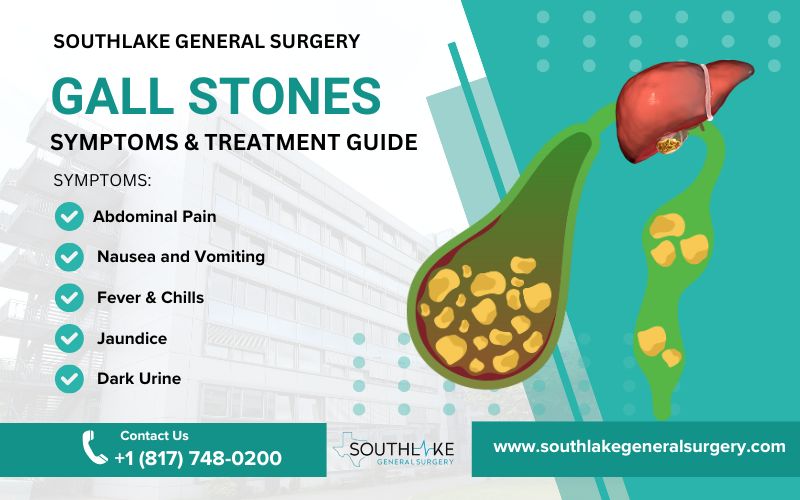Gall stones, also known as cholelithiasis, consist of hardened bile that develops within the gallbladder or bile ducts. They are prevalent, particularly among women and individuals designated female at birth.
Gallstones may remain asymptomatic, yet they can lead to complications if they obstruct the biliary tract and block bile flow. If your gallstones lead to symptoms, treatment will be necessary to eliminate them — usually through surgical intervention.
Key Highlights
- Gallstones are hardened substances that develop inside the gallbladder. They can obstruct the movement of the bile which is essential for the digestion process.
- Most of the time, they do not cause symptoms, but they can lead to sharp pain. This pain can move to the back and shoulders.
- There are several risk factors for gallstones. Factors such as excessive body weight, rapid weight loss, and genetic predisposition are included.
- To find out if someone has gallstones, doctors often use imaging methods like ultrasounds and blood tests. They check the liver function too.
- There are different treatment options. These can be surgery to remove the gallbladder or non-surgical methods like lithotripsy.
Understanding Gallstones
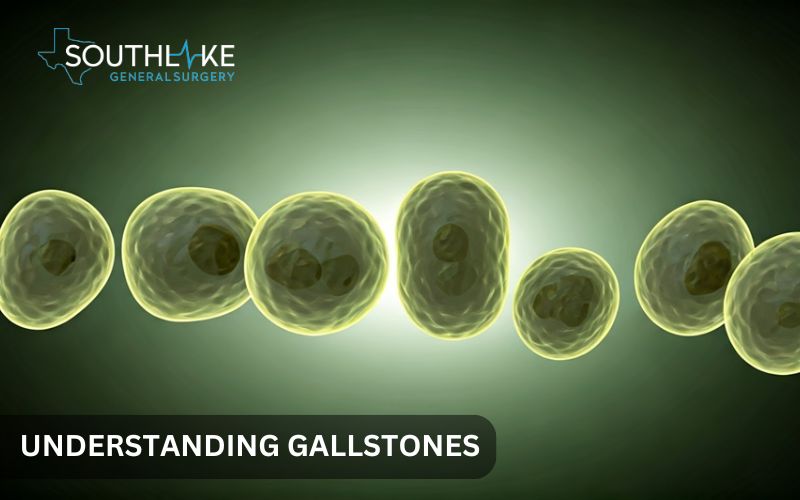
Gallstones are hardened, concentrated structures of bile that form in the gallbladder or bile ducts. “Gall” refers to bile, thus gallstones are essentially stones formed from bile.
Your gallbladder functions as a storage unit for bile. It collects and reserves bile for future utilization. The liver generates bile, which subsequently travels through the bile ducts to various organs within the biliary system.
Defining Gallstones and Their Importance
Gallstone disease happens when the bile in the gallbladder turns into solid crystals. This usually occurs because of cholesterol. These crystals can grow into cholesterol stones. When this happens, it can obstruct the normal movement of bile.
- The biliary system produces, stores, and moves the bile. It needs clear paths to work well.
- Gallstones can block these paths. This can cause severe pain, swelling, and even infections.
- It is key to notice the signs of gallstone disease. Early awareness helps with quick diagnosis and treatment. This can stop more problems and keep your biliary system healthy over time.
Categories and Textures of Gallstones
Gall stones mostly come in two types. The first type is cholesterol stones. The second type is pigment stones.
- Cholesterol stones are the most common type. These stones occur when there is an excess of cholesterol present in the bile.
- Pigment stones are made from bilirubin. Bilirubin is a waste produced that occurs when red blood cells are broken down in the body.
If you have these types of gall stones, they can indicate health problems, such as diseases of the liver or issues with your blood.
Identifying Gallstone Symptoms
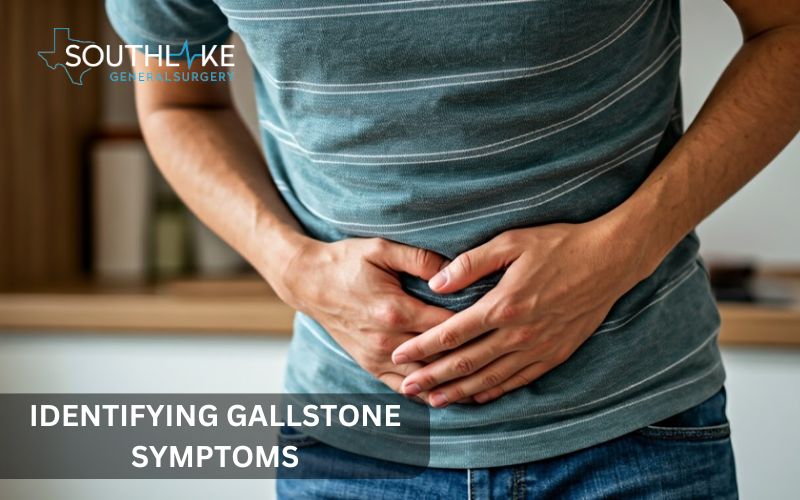
Certain individuals might not experience any symptoms. However, gallstones can lead to significant pain in the upper right area of the abdomen. This pain might feel like heartburn which can also spread to the back or shoulders. These factors can make diagnosis hard.
Early Signs of Gallstones Symptoms
Biliary colic is often one of the initial signs of gallstones. This causes intense pain in the upper right section of the abdomen. The pain occurs when a stone blocks the bile duct. It can get worse after eating, especially if the meal is fatty. The following are some of the additional symptoms to watch for:
- Feeling sick and throwing up when in severe pain, indicating a blockage.
- Having indigestion, bloating, and gas due to limited bile flow.
If you do not treat gallstones, they can lead to acute cholecystitis. This is a serious inflammation of the gallbladder. It is very important to get medical help quickly to avoid dangerous complications.
When to seek medical help for Gall stone Disease
If you experience severe pain in your upper right abdomen after your meal, it is recommended to consult your physician immediately. This type of pain may indicate various underlying problems. However, given that it happens post-meals and, in that region, it could be a sign of gallstone pain.
If you ignore this severe pain, it could lead to serious problems. One such problem is inflammation of the gallbladder, and this can be life-threatening. This is why getting medical help is really important.
When you get medical help quickly, you can get the correct diagnosis. This looks for other health conditions. It also helps you choose the best treatment options for gallstones.
The Science Behind Gallstones Formation
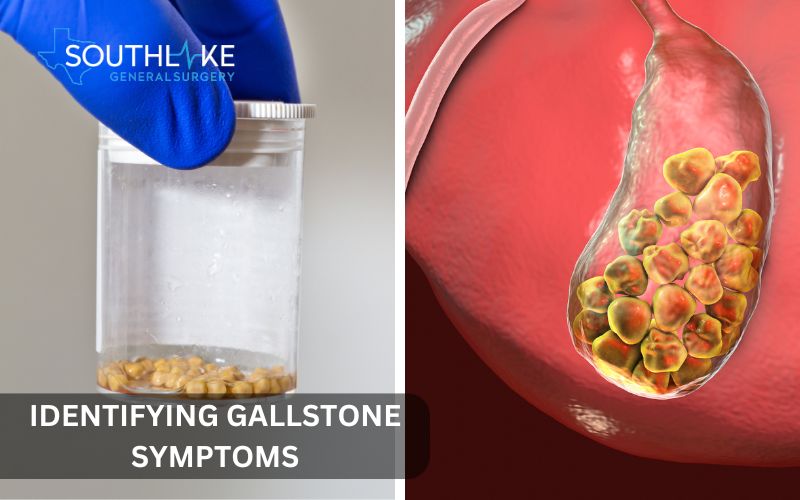
Gallstones develop when the composition of bile within the gallbladder is not balanced. If there is too much cholesterol or bilirubin, these substances can build up in the bile. Over time, they can come together and become stones.
It is important to change how you live and what you eat. Knowing this can help you learn how to prevent gallstones.
Role of Cholesterol and Bilirubin
Excess cholesterol in the gallbladder is the main reason for gallstones, which are called cholesterol stones. When an excess amount of bilirubin is produced, this can lead to the formation of pigment stones.
This primarily occurs due to the alteration of the liver’s processing of the bilirubin. You can reduce the chances of the formation of gallstones, by adding these essential tips:
- Keep your cholesterol levels in control.
- Take care of any health issues that may increase your bilirubin production.
- Always eat healthy food and live a good lifestyle to prevent gallstones.
How Does Your Gallbladder Function Affect Stone Formation
The gallbladder is an essential organ for your digestion process. Your gallbladder stores and releases the bile that helps in digestion. When bile is released in the small intestines it helps to break down fats. If the gallbladder does not function properly, it can lead to the formation of stones.
When the gallbladder does not empty properly, the bile can become stuck, leading to a thick buildup of bile. This buildup can turn cholesterol or bilirubin into stones.
A blockage in the bile duct caused by gallstones can lead to significant complications and block the normal flow of bile. When this bile flow is obstructed, it can cause gallbladder inflammation and can create pressure in the gallbladder. This extra pressure can even exacerbate your problem.
Your doctor may suggest gallbladder removal surgery to restore your digestion.
What are the Risk Factors and Prevention for Gallbladder Gallstones
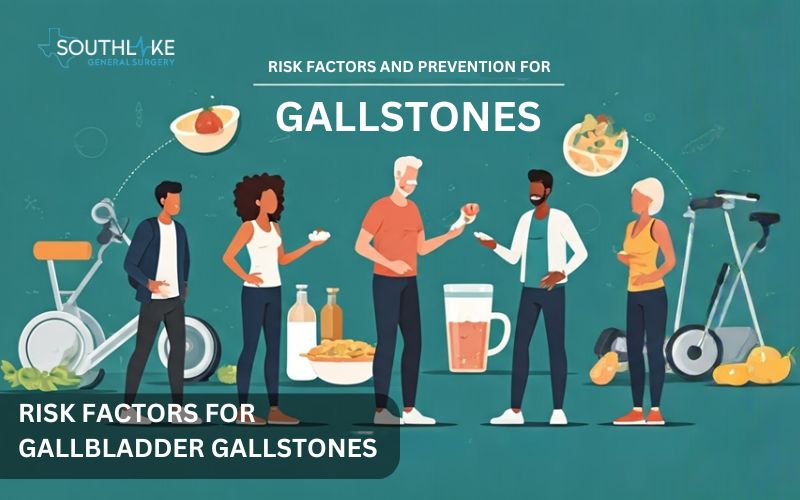
There are several factors that can increase the risk of gallstone formation, such as genetic predisposition and lifestyle.
Although it is impossible to change genes but certainly you can reduce the risk of gallstones by living a healthy lifestyle. To prevent gallstones, you can maintain a healthy weight, eat healthy and fresh foods, and stay active. These small changes can lower the risk of getting gallstones.
Demographic and Lifestyle Influences
Anyone can experience the problem of gallstones. However, certain individuals have a higher propensity to experience them. Here are some aspects that can raise the risk:
- A family’s history
- Overweight issues
- Rapid reduction in body weight, such as after weight loss surgery
If weight issues run in your family or if your weight frequently changes, you need to take action. Managing your risk is very important.
Dietary Habits and Gallstone Risk
Your eating habits can greatly affect your chance of getting gallstones. The following are some important points to keep in mind:
- A diet high in saturated fats and cholesterol and low in fiber can increase the risk of gallstones.
- It is good to be cautious and avoid fast food, processed snacks, and fatty meats.
- To help keep your bile healthy, try eating more fiber-rich meals. This includes a variety of fruits, vegetables, and whole grains.
- Adding fiber to your diet helps your body to get rid of excess cholesterol. This prevents the accumulation of cholesterol in the gallbladder.
It’s important for you to build healthy eating habits. This can help lower the risk of gallstones.
Here are some good habits that you can practice:
- Regular Mealtimes: You should stick to a regular eating schedule. Do not go for long periods without eating or skipping meals.
- Hydration: Drink plenty of water every day. It helps with digestion and supports bile flow.
- Mindful Eating: You must listen to your body’s hunger signals. Do not eat more than needed, as this can stress the digestive system.
Professional Diagnosis Procedures
If you are showing signs of gallstones, your doctor will conduct assessments through blood tests and imaging tests. Blood tests can identify signs of inflammation, infection, or jaundice, providing insights into which organs may be impacted. Imaging assessments will assist in identifying the origin of the obstruction within your biliary system.
Imaging and Laboratory Tests Explained
An abdominal ultrasound is often the first test to check for gallstones. This test is safe to have. It uses sound waves to create pictures of the gallbladder. It can help find out if there are any stones in the gallbladder.
If the ultrasound doesn’t show clear results, the doctor may suspect that there are stones in the bile ducts. In this case, they might need to do more tests, which may include:
- Magnetic Resonance Cholangiopancreatography (MRCP). This procedure provides detailed images of the bile ducts.
- CT Scan, to look at the whole abdominal area.
Blood tests are also important with imaging tests. They check how healthy the liver is. Blood tests can also look for signs of swelling or infection. There may be a problem with the bile duct if specific enzyme levels in the blood are high.
Contemporary Treatments for Gallstones
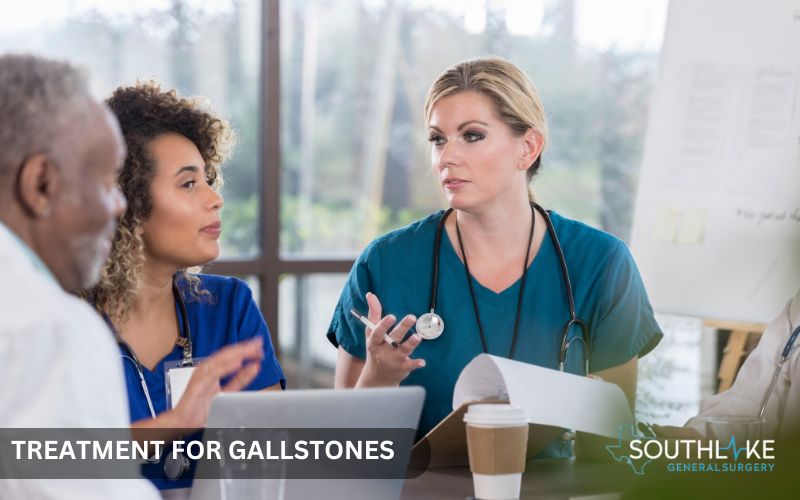
Treatment for gallstones varies based on symptoms and issues. If your gallstones remain asymptomatic, treatment may not be necessary.
However, if gallstones cause blockage in your biliary tract, your doctor will aim to remove all the stones— not just the blockage. After blockage caused by gallstones, the probability of recurrence is significantly high.
Many individuals who require treatment for gallstones usually undergo surgery to have them removed. Gallbladder surgery is the most effective way to prevent gallstones from causing problems for you in the future.
If surgery isn’t an option for you or if you prefer not to go that route, there are several alternative treatments available to consider, such as medications and various procedures.
Surgical Options: From Laparoscopic to Open Surgery
Laparoscopic cholecystectomy is an effective method for addressing gallstones that lead to complications. These problems can be things like acute pancreatitis and an increased chance of gallbladder cancer.
This surgery is less invasive. It uses small incisions, and a tool called a laparoscope, which is a thin tube with a camera. The surgeon removes the gallbladder through these small incisions. Because of this, recovery is faster, there is less scarring, and people feel less pain after the surgery.
If laparoscopic cholecystectomy doesn’t work for you, open cholecystectomy could be a choice. This is a common surgery. It needs a bigger cut to take out the gallbladder. It works well, but recovery takes longer than with laparoscopic cholecystectomy.
Choosing between these two ways depends on several things. These things are the size of the stones, the patient’s health, and the surgeon’s skill. No matter which method is chosen, gallbladder surgery will remove the gallstones and prevent them from coming back.
Non-Surgical Treatments and Their Efficacy
For people who can’t have surgery or have small cholesterol stones, non-surgical options can be good. Bile acids include ursodeoxycholic acid. It can help break down certain cholesterol gallstones over time. However, this treatment may take several months or even years to work or it may not work for all types of gall stones.
There is another procedure known as shock wave lithotripsy which uses strong shock waves to break big gallstones into smaller pieces. These smaller pieces can pass through your bile duct. This method can be useful for a few individuals, but it does not address the reason why gallstones form. Because of this, there is a high possibility that the stones might come back.
Before you choose any of these non-surgical treatments, it is always recommended to consult your doctor. Certain factors need to be addressed such as the type of stone, its size, and your overall health matter. Your doctor will help determine if these treatments will be effective for you.
Life After Gallbladder Removal Surgery
After having your gallbladder removed, you’ll find that adjusting your eating habits and digestion is an important part of your recovery journey. Let’s explore the changes that occur after gallbladder removal surgery.
How Your Body Adapts:
After surgery, bile produced by your liver flows directly into the small intestine. This change may influence the way your body handles fat.
Possible Side Effects:
You might experience these possible side effects after your gallbladder removal:
- Loose stools after fatty meals. There’s no need to worry, it’s manageable!
- Bloating, diarrhea, or other symptoms that may occur after gallbladder removal (post-cholecystectomy syndrome)
Many patients find that they can return to their usual activities within just a few days. This can be achieved through a balanced diet that is low in fat and high in fiber, it can help manage these issues. Regular visits to your healthcare provider are equally important to keep a check on your health.
Living with Gallbladder stone
People living with gallstones means they need to manage the symptoms that they are experiencing and avoid complications. This means finding out what makes you feel pain. You should also change your eating habits and focus on being healthier.
You can use these methods to feel better. They can also cut down on gallstone issues. This will help improve your overall digestive health.
Managing Gall Stone Symptoms through Diet and Lifestyle
Managing gallstone symptoms starts with changing your diet and lifestyle. Here are some key tips to help lessen symptoms and prevent future problems:
- Add a sufficient amount of fruits, vegetables, and whole grains to your diet.
- Lower your fat and cholesterol intake.
- Maintain a healthy weight. And try to lose weight gradually and steadily.
- Avoid rapid weight loss techniques and an extreme diet plan.
- Incorporating regular exercise into your routine can be beneficial for your gallbladder and it can also improve your digestion.
When to Consider Gallbladder Surgery
When changes in your lifestyle help but do not fully control gallstone symptoms, you should think about surgery. If you have several gallbladder attacks with severe pain and an upset stomach, it may be time to get more help.
Other problems, such as a blocked bile duct, infections, or swelling, might make surgery necessary. Ignoring these problems can cause serious health complications. This includes diseases like pancreatitis or even a ruptured gallbladder.
Surgery is usually the best solution for these problems. A laparoscopic cholecystectomy is an excellent choice. This approach provides a durable solution for gallstone disease and helps minimize the possibility of recurrence and helps prevent future health issues.
Conclusion
Gallstones can significantly impact your health and lead to pain. If you’re experiencing symptoms, it is important to seek medical help quickly. You need to be aware of the symptoms and treatment options to manage this issue well. After your health examination, your doctor can suggest the treatment options available for you.
These options may include non-surgical methods and surgical procedures such as gallbladder removal surgery, depending on what each person needs.
Managing your eating habits and lifestyle can help reduce symptoms and lower the risk of complications. If surgery is necessary, it’s very important to discuss the options with a doctor.
By staying informed and taking action, you can manage the symptoms caused by gallstones and it can also improve your quality of life.
Make an Appointment
For help with gallstones, you can see Dr. Valeria Simone, MD. She works at Southlake General Surgery in Texas, USA. To get expert care for gallstone disease or gallbladder surgery, you can call +1 (817) 748-0200.
Dr. Simone is skilled in laparoscopic cholecystectomy and treating bile duct problems. She offers different treatment options for gallstone symptoms. You can trust her to help you with all your gallstone concerns.
Frequently Asked Questions
Can diet alone dissolve gallstones?
A nutritious diet incorporating olive oil and low cholesterol is beneficial. It may not eliminate gallstones. Modifying your diet can ease symptoms, prevent new stones, and aid digestion. The effect of diet on gallstones differs based on stone size and type. Pigment stones are less responsive to dietary changes. The bile duct obstruction is also critical.
What is the duration of recovery after gallstone surgery?
For every individual, recovery time can vary based on the type of surgery and their health conditions. If you had a laparoscopic cholecystectomy, you could usually get back to your daily routine in one to two weeks. On the other hand, open cholecystectomy involves a longer healing process and could necessitate several weeks for recovery.
Is there anything you can do naturally to get rid of gallstones?
Some natural remedies may help you with gallstone disease. People say that drinking olive oil or using herbal supplements may have beneficial effects. Unfortunately, there isn’t enough proof from scientific studies to support their effectiveness. It’s best to talk to your healthcare professional about safe treatment options that are supported by substantial evidence.
Can gallstones reoccur after treatment?
Gallstones coming back after gallbladder removal are uncommon. Still, if you have risk factors, such as a family history or some medical issues, new stones can form. This typically happens in the bile ducts, but it does not occur very often.
How can I prevent gallstones if I have a family history?
Individuals who have a familial predisposition to gallstones may lower their chances of developing them by adopting a nutritious diet, keeping a healthy weight, and engaging in consistent physical activity. By following these steps can significantly lower your risk.
Is it possible to remove gallstones surgically without removing the gallbladder?
Yes. Gallstones can be removed from the gallbladder without necessitating the complete removal of the organ. This procedure, known as gallstone removal or cholelithotomy, involves extracting the stones while keeping the gallbladder intact. Doctors commonly use endoscopic techniques such as ERCP or a small incision in the stomach.
Medically Reviewed By: Dr. Valeria Simone MD
Board-certified General Surgeon at Southlake General Surgery, Texas, USA.
Follow us on Facebook and YouTube.
References:
- Jones, M. W., Weir, C. B., & Ghassemzadeh, S. (2024, August 17). Gallstones (Cholelithiasis). StatPearls – NCBI Bookshelf. https://www.ncbi.nlm.nih.gov/books/NBK459370/
- Gulaya, K., Desai, S., & Sato, K. (2016). Percutaneous Cholecystostomy: Evidence-Based Current Clinical Practice. Seminars in Interventional Radiology, 33(04), 291–296. https://doi.org/10.1055/s-0036-1592326
- Stinton, L. M., & Shaffer, E. A. (2012). Epidemiology of Gallbladder Disease: Cholelithiasis and Cancer. Gut And Liver, 6(2), 172–187. https://doi.org/10.5009/gnl.2012.6.2.172
- Treatment for Gallstones. (2022, August 30). National Institute of Diabetes and Digestive and Kidney Diseases. https://www.niddk.nih.gov/health-information/digestive-diseases/gallstones/treatment
- Endoscopic Retrograde Cholangiopancreatography (ERCP). (2024, October 4). National Institute of Diabetes and Digestive and Kidney Diseases. https://www.niddk.nih.gov/health-information/diagnostic-tests/endoscopic-retrograde-cholangiopancreatography
- Gallstones – NIDDK. (n.d.). National Institute of Diabetes and Digestive and Kidney Diseases. https://www.niddk.nih.gov/health-information/digestive-diseases/gallstones

